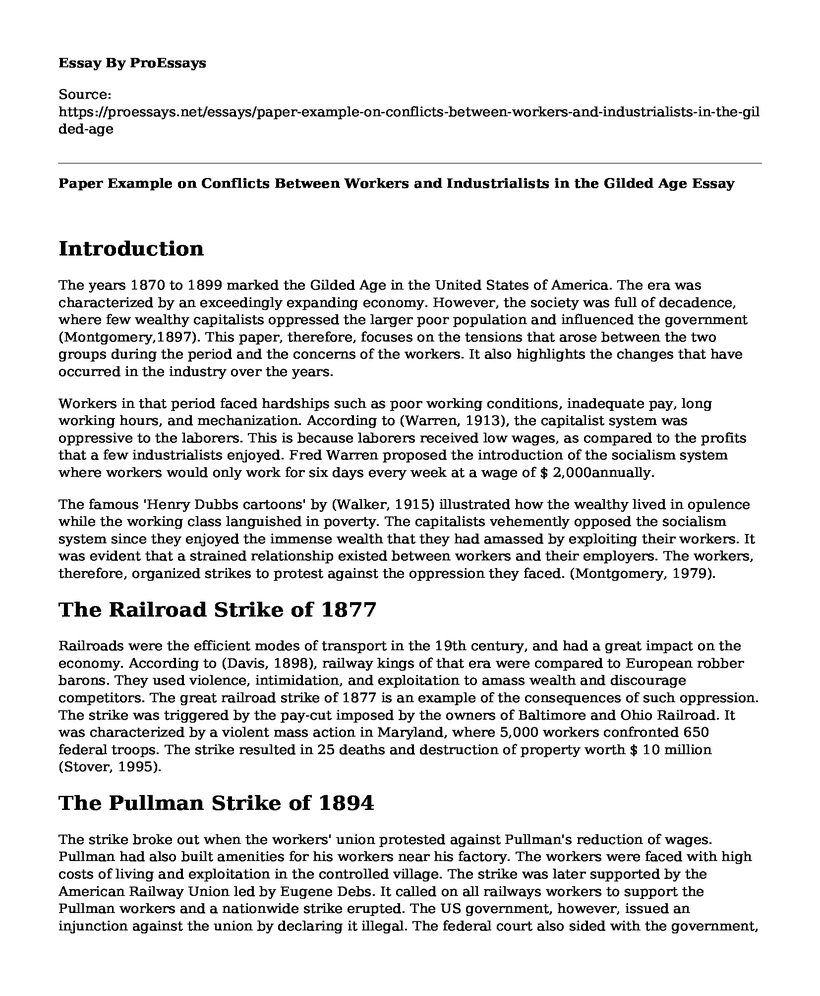Introduction
The years 1870 to 1899 marked the Gilded Age in the United States of America. The era was characterized by an exceedingly expanding economy. However, the society was full of decadence, where few wealthy capitalists oppressed the larger poor population and influenced the government (Montgomery,1897). This paper, therefore, focuses on the tensions that arose between the two groups during the period and the concerns of the workers. It also highlights the changes that have occurred in the industry over the years.
Workers in that period faced hardships such as poor working conditions, inadequate pay, long working hours, and mechanization. According to (Warren, 1913), the capitalist system was oppressive to the laborers. This is because laborers received low wages, as compared to the profits that a few industrialists enjoyed. Fred Warren proposed the introduction of the socialism system where workers would only work for six days every week at a wage of $ 2,000annually.
The famous 'Henry Dubbs cartoons' by (Walker, 1915) illustrated how the wealthy lived in opulence while the working class languished in poverty. The capitalists vehemently opposed the socialism system since they enjoyed the immense wealth that they had amassed by exploiting their workers. It was evident that a strained relationship existed between workers and their employers. The workers, therefore, organized strikes to protest against the oppression they faced. (Montgomery, 1979).
The Railroad Strike of 1877
Railroads were the efficient modes of transport in the 19th century, and had a great impact on the economy. According to (Davis, 1898), railway kings of that era were compared to European robber barons. They used violence, intimidation, and exploitation to amass wealth and discourage competitors. The great railroad strike of 1877 is an example of the consequences of such oppression. The strike was triggered by the pay-cut imposed by the owners of Baltimore and Ohio Railroad. It was characterized by a violent mass action in Maryland, where 5,000 workers confronted 650 federal troops. The strike resulted in 25 deaths and destruction of property worth $ 10 million (Stover, 1995).
The Pullman Strike of 1894
The strike broke out when the workers' union protested against Pullman's reduction of wages. Pullman had also built amenities for his workers near his factory. The workers were faced with high costs of living and exploitation in the controlled village. The strike was later supported by the American Railway Union led by Eugene Debs. It called on all railways workers to support the Pullman workers and a nationwide strike erupted. The US government, however, issued an injunction against the union by declaring it illegal. The federal court also sided with the government, and the strike came to an end (Schneirov et.al, 1999).
Changes in Labor
There was a remarkable improvement in the unionization of workers in the 20th century. Moreover, the federal government intervened by granting unions the rights to organize legally. This led to the establishment of a minimum wage provision and insurance covers for the workers (Derrickson, 2000). Industrial revolution however had some limitations such as exposure of workers to toxic chemicals and their loss of skills (Reeve, 1907).
Conclusion
In conclusion, the industrial revolution during the gilded age had a huge impact on the society. Tension between workers and industrialists was evident and it resulted in violent episodes. Organization of workers to protest against injustices led to changes in the labor market.
References
Davis, J. (1898). Our American Kings Compared to the Robber Barons of Europe. Tiller and Toiler, page 3.https://www.newspapers.com/image/190139571Derickson, A. (2000). "Take Health from the List of Luxuries": Labor and the Right to Health Care, 1915-1949. Labor History ; 41:171-87. [PubMed]
Montgomery, D. (1979). Workers' Control in America: Studies in the History of Work, Technology, and Labor Struggles. New York: Cambridge University Press, 20.
Montgomery, D. (1987). The Fall of the House of Labor. Cambridge: Cambridge University Press;Monthly Labor Review. Compensation for Occupational Diseases under Workmen's Compensation Laws. 1916;3:222-3.
Reeve, AB. (1907).The Death Roll of Industry. Charities and the Commons; 17:791.
Walker, R. (1915). New Adventures of Henry Dubb.Chicago: Socialist Party.
Warren, FD.(1913). $2,000 Per Year and a six-hour day.Kansas:Book Department Appeal to Reason.
Schneirov, R., Stromquist, S., & Salvatore, N. (Eds.). (1999). The Pullman Strike and the Crisis of the 1890s: Essays on Labor and Politics. University of Illinois Press.
Stover, J. F. (1995).History of the Baltimore and Ohio Railroad.Purdue University Press.
Cite this page
Paper Example on Conflicts Between Workers and Industrialists in the Gilded Age. (2022, Aug 15). Retrieved from https://proessays.net/essays/paper-example-on-conflicts-between-workers-and-industrialists-in-the-gilded-age
If you are the original author of this essay and no longer wish to have it published on the ProEssays website, please click below to request its removal:
- Mahatma Gandhi: An Indian Model of Servant Leadership
- Comparing and Contrasting the Achievements of Richard Milhous Nixon and Barack Obama
- Causes and Consequences of the French Indian War - Essay Sample
- Essay Sample on Soviet Union's Rise: Stalin's Totalitarian Policies & WW2 Impact
- WWII Concentration Camps: A Global Scourge - Research Paper
- Essay Sample on Exploring Ancient Maya Religion & Civilizations: Analysis & Comparison
- The Columbian Exchange: Uniting Old and New Worlds - Essay Example







